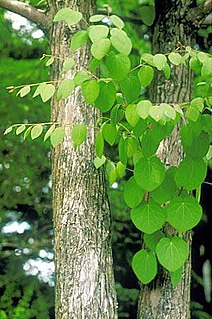
Cercidiphyllum is a genus containing two species of plants, both commonly called katsura. They are the sole members of the monotypic family Cercidiphyllaceae. The genus is native to Japan and China and unrelated to Cercis (redbuds).

Commelina is a genus of approximately 170 species commonly called dayflowers due to the short lives of their flowers. They are less often known as widow's tears. It is by far the largest genus of its family, Commelinaceae. The Swedish taxonomist Carl Linnaeus of the 18th century named the genus after the two Dutch botanists Jan Commelijn and his nephew Caspar, each representing one of the showy petals of Commelina communis.

Zantedeschia is a genus of eight species of herbaceous, perennial, flowering plants in the family Araceae, native to southern Africa from South Africa north to Malawi. The genus has been introduced on all continents except Antarctica. Common names include arum lily for Z. aethiopica and calla and calla lily for Z. elliottiana and Z. rehmannii, although members of the genus are neither true lilies of Liliaceae, true Arums, nor true Callas. The colourful flowers and leaves of both species and cultivars are greatly valued and commonly grown as ornamental plants.
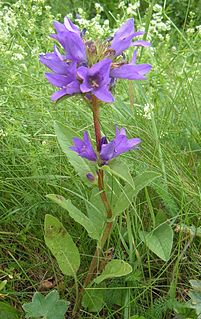
Campanula glomerata, known by the common names clustered bellflower or Dane's blood, is a species of flowering plant in the genus Campanula, belonging to the family Campanulaceae. It is the county flower of Rutland, England.

Banksia paludosa, commonly known as the marsh or swamp banksia, is a species of shrub in the plant genus Banksia. It is native to New South Wales, Australia, where it is found between Sydney and Batemans Bay, with an isolated population further south around Eden. There are two recognised subspecies, the nominate of which is a spreading shrub to 1.5 m (5 ft) in height, and subsp. astrolux is a taller shrub to 5 m (16 ft) high found only in Nattai National Park.

Commelina communis, commonly known as the Asiatic dayflower, is an herbaceous annual plant in the dayflower family. It gets its name because the blooms last for only one day. It is native throughout much of East Asia and northern parts of Southeast Asia. In China, the plant is known as yazhicao, roughly translating to "duckfoot herb", while in Japan it is known as tsuyukusa, meaning "dew herb". It has also been introduced to parts of central and southeastern Europe and much of eastern North America, where it has spread to become a noxious weed. It is common in disturbed sites and in moist soil. The flowers emerge from summer through fall and are distinctive with two relatively large blue petals and one very reduced white petal.

Emilia sonchifolia, also known as lilac tasselflower or cupid's shaving brush, is tropical flowering species of tasselflower in the sunflower family. It is widespread in tropical regions around the world, apparently native to Asia and naturalized in Africa, Australia, the Americas, and various oceanic islands.

Commelina diffusa, sometimes known as the climbing dayflower or spreading dayflower, is a pantropical herbaceous plant in the dayflower family. It has been introduced to the southeastern United States where it is most common in wet disturbed soils. There are two recognised varieties, one being the type and the other being C. diffusa var. gigas, which is native to Asia and has been introduced to Florida. It flowers from spring to fall and is most common in disturbed situations, moist places and forests. In China the plant is used medicinally as a febrifuge and a diuretic. A blue dye is also extracted from the flower for paints. In the Hawaiian Islands, it is known as "honohono grass", although it is technically not a grass. "Honohono" refers to the alternating structure of the leaves. At least one publication lists it as an edible plant in New Guinea.
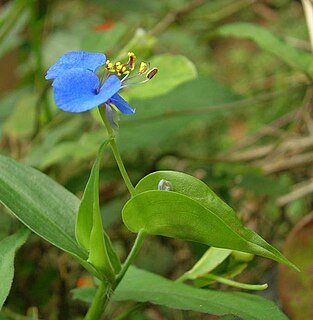
Commelina caroliniana, sometimes known as the Carolina dayflower, is an herbaceous plant in the dayflower family native to India and Bangladesh. Both the scientific name and the common name are misleading as the plant was described based on specimens found in the southeastern United States before it was known that the plant had in fact been introduced from India. It was most likely introduced to South Carolina in the late 17th century along with rice seed from India. The plant has also been recently reported from South Korea. Its flowers emerge from summer to fall and rarely into the winter.

Commelina benghalensis, commonly known as the Benghal dayflower, tropical spiderwort, or wandering Jew, kanshira in Bengali, is a perennial herb native to tropical Asia and Africa. It has been widely introduced to areas outside its native range, including to the neotropics, Hawaii, the West Indies and to both coasts of North America. It has a long flowering period, from spring to fall in subtropical areas, and throughout the year closer to the equator. It is often associated with disturbed soils.
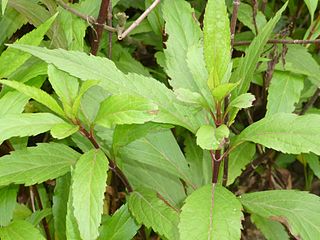
Eupatorium fortunei is a plant species in the family Asteraceae native from Asia where it is rare in the wild but commonly cultivated. The white to reddish colored flowers and herbage smell like lavender when crushed. In China the plants are used to make fragrant oils.
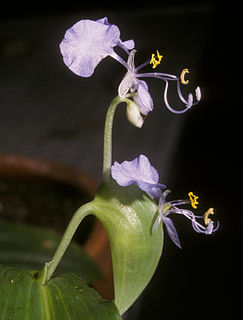
Commelina lukei is a monocotyledonous, herbaceous plant in the dayflower family from East Africa. This blue-flowered herb has been recorded in lowland areas of Kenya, Tanzania, and Madagascar, where it is found in a variety of habitats ranging from forests to grasslands to roadsides. Described in 2008, the species was previously confused with Commelina mascarenica and Commelina imberbis. Despite this misinterpretation, a third similar species, Commelina kotschyi, is actually most closely related to C. lukei. The plant's distinctive features include a scrambling habit, capsules with a rounded extension at the apex, appendaged seeds, clasping leaf bases throughout, and solely needle-like hairs along the upper side of the leaf's midrib. The species was named in honour of the botanist W. Q. R. Luke, whose collection of the plant served as the type specimen and allowed for a complete illustration and description.

Polyarrhena is a genus of low, branching shrublets that is assigned to the daisy family. Its stems are alternately and densely set with entire or somewhat toothed leaves. Like in almost all Asteraceae, the individual flowers are 5-merous, small and clustered in typical heads, and which are surrounded by an involucre of in this case three whorls of bracts. In Polyarrhena, the centre of the head is taken by yellow disc florets, and is surrounded by one single whorl of white ligulate florets that have a pinkish-purple wash on the underside. These florets sit on a common base and are not individually subtended by a bract. The species occur in the Cape Floristic Region. Polyarrhena reflexa has long been cultivated as an ornamental and is often known under its synonym Aster reflexum.
Cavea is a low perennial herbaceous plant that is assigned to the daisy family. Cavea tanguensis is currently the only species assigned to this genus. It has a basal rosette of entire, slightly leathery leaves, and stems of 5–25 cm high, topped by bowl-shaped flower heads with many slender florets with long pappus and purplish corollas. The vernacular name in Chinese is 葶菊. It grows high in the mountains of China (Sichuan), Tibet, India (Sikkim), and Bhutan, and flowers in July and August.
Commelina sphaerorrhizoma is a monocotyledonous, herbaceous plant in the dayflower family from south-central Africa. This blue-flowered herb has been recorded from western Zambia, central Angola, and the southern portion of the Democratic Republic of the Congo, although at the time of its description it was known only from 11 collections and may be more broadly distributed. It is found in a variety of habitats ranging from woodlands to grasslands to roadsides. The plant's most distinctive feature and the source of its scientific name is its moniliform rhizome composed of spherical segments that can form a bead-like chain. Other distinguishing characteristics include glaucous leaves with clasping bases, unfused and virtually hairless spathes, capsules composed of three, one-seeded locules, and very large seeds with a hairy surface.

Rheum australe, synonym Rheum emodi, is a flowering plant in the family Polygonaceae. It is commonly known as Himalayan rhubarb, Indian rhubarb and Red-veined pie plant. It is a medicinal herb used in the Indian Unani system of medicine, and formerly in the European system of medicine where it was traded as Indian rhubarb. The plant is found in the sub-alpine and alpine Himalayas at an altitude of 4000 m.

Pandanus furcatus Roxb., also known as korr, pandan or Himalayan/Nepal screw pine, is native to the Sikkim Himalaya of Northeast India, Bhutan and Nepal, Malaysia, Indonesia, Australia and West Africa, and occurs on moist and shady slopes of ravines between 300 and 1500 m. As might be expected it is cold-resistant and able to tolerate occasional light frost, slowly growing to a tall branched tree - about 17 m at maturity - and perched on stilt-like aerial roots. The crown is made up of 5 m long, pale-green leaves, with finely toothed margins, while its fruits are sweet-tasting and edible. The leathery flower spathes are golden-yellow, the lowermost are largest and about 1m in length. These give rise to cone-like fruits, 15–25 cm long, that are bright orange to red when mature and consist of 5-6 angled drupes.
Commelina polhillii is a plant species native to Tanzania, known only from the Iriniga and Mpanda Districts. It occurs in open woodlands and in disturbed sites.
Iris subdichotoma is a plant species in the genus Iris, it is also in the subgenus Limniris and in the section Lophiris. It is a rhizomatous perennial, from Tibet and China, with pale blue, blue-purple, purple, violet or white flowers. It is cultivated as an ornamental plant in temperate regions.
Caltha scaposa is a low, perennial herb with one or two yellow hermaphrodite saucer-shaped flowers. This marsh-marigold species belongs to the buttercup family, grows in moist alpine fields and is native to the eastern Himalayas and the mountains on the eastern margin of the Tibetan highland.















